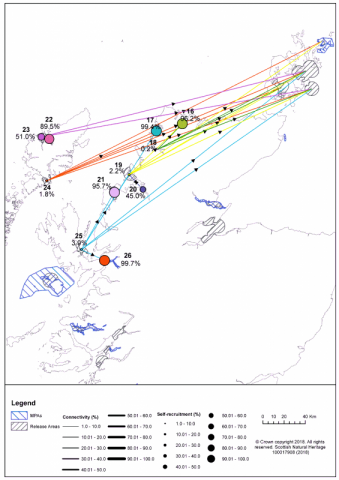Biological connectivity and fish larvae
Biological connectivity
The flow fields from the wider domain Scottish Shelf Model (SSM) and finer resolution SSM sub-models are well suited for studying how the flow around Scotland can transport organisms such as invertebrates and fish larvae, parasites such a sea lice, and diseases or pollutants. The high resolution flow fields from the sub-models have also been combined to give an extremely high resolution flow field across the whole of the Scottish Shelf. Connectivity studies are therefore not limited to small geographic areas, but can be used to study connectivity across UK shelf seas. An example of this is the connectivity study conducted for finfish aquaculture farm management areas (FMA), helping to understand whether sea lice originating from one area could infect other areas (Rabe and Gallego, 2020). There has also been a number of studies focussing on the connectivity of benthic species within the Marine Protected Areas (MPA) network (e.g. Millar et al. 2019), and other habitat areas, which could, for example, be directly used to support MPA decision making (relative importance of different MPAs, ideal location, etc.). For example, this work has shown how Shetland horse mussel beds may be biologically connected to west coast horse mussels. How this connectivity could change with climate change has also been investigated, using a future climatology (representing 2050) from the SSM. The potential effect of large scale tidal stream developments on benthic species connectivity has also been investigated as part of the EcoWatt2050 project (http://marine.gov.scot/information/ecowatt2050, https://www.masts.ac.uk/media/36374/ecowatt2050-booklet.pdf).


